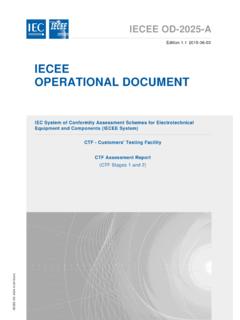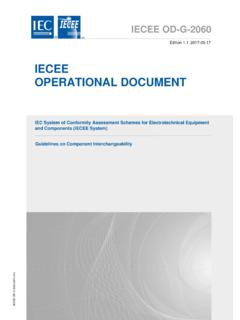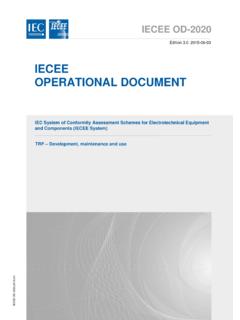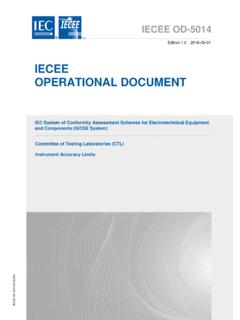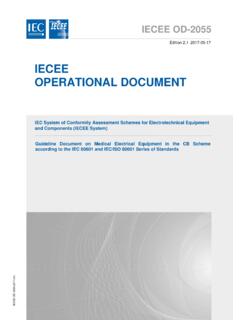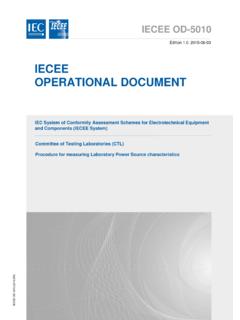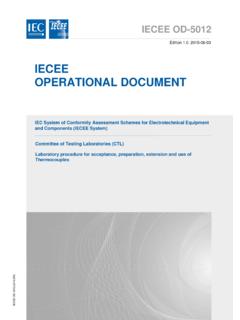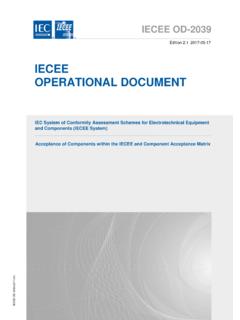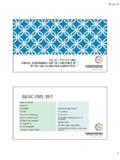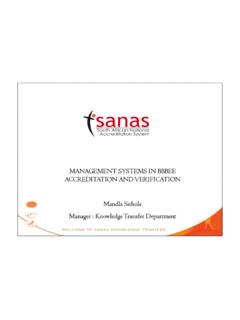Transcription of IECEE OPERATIONAL DOCUMENT
1 IECEE OD-5013 Edition 2015-06-03 IECEE OPERATIONAL DOCUMENT Committee of Testing Laboratories (CTL) Leakage (Touch) Current measurement Instruments IECEE OD-5013:2015(EN) IEC System of Conformity Assessment Schemes for Electrotechnical Equipment and Components ( IECEE System) THIS PUBLICATION IS COPYRIGHT PROTECTED Copyright 2015 IE C, Geneva, Switzerland All rights reserved. Unless otherwise specified, no part of this publication may be reproduced or utilized in any form or by any means, electronic or mechanical, including photocopying and microfilm, without permission in writing from either IEC or IEC's member National Committee in the country of the requester. If you have any questions about IEC copyright or have an enquiry about obtaining additional rights to this publication, please contact the address below or your local IEC member National Committee for further information.
2 IEC Central Office Tel.: +41 22 919 02 11 3, rue de Varemb Fax: +41 22 919 03 00 CH-1211 Geneva 20 Switzerland About the IEC The International Electrotechnical Commission (IEC) is the leading global organization that prepares and publishes International Standards for all electrical, electronic and related technologies. About IEC publications The technical content of IEC publications is kept under constant review by the IEC. Please make sure that you have the latest edition, a corrigenda or an amendment might have been published. Use ful links: IEC publications search - The advanced search enables you to find IEC publications by a variety of criteria (reference number, text, technical committee,..). It also gives information on projects, replaced and withdrawn publications.
3 IEC Just Published - Stay up to date on all new IEC publications. Just Published details all new publications released. Available on-line and also once a month by email. Electropedia - The world's leading online dictionary of electronic and electrical terms containing more than 30 000 terms and definitions in English and French, with equivalent terms in additional languages. Also known as the International Electrotechnical Vocabulary (IEV) on-line. Customer Service Centre - If you wish to give us your feedback on this publication or need further assistance, please contact the Customer Service Centre: IECEE OD-5013 Edition 2015-06-03 IECEE OPERATIONAL DOCUMENT Committee of Testing Laboratories (CTL) Leakage (Touch) Current measurement Instruments INTERNATIONAL ELECTROTECHNICAL COMMISSION ZZ PRICE CODE IEC System of Conformity Assessment Schemes for Electrotechnical Equipment and Components ( IECEE System) IECEE OD-5013:2015 IEC 2015 2 CONTENTS CONTENTS.
4 2 Background .. 3 1 Purpose .. 3 2 Scope .. 3 3 Normative References .. 3 4 Definitions .. 3 5 Abbreviations .. 3 6 Calibration of Leakage (Touch) Current measurement Instruments .. 3 7 Peak and True RMS Touch Current .. 4 8 Leakage (Touch) Current measurement Instruments .. 4 9 Availability of Commercially Made Integral Leakage (Touch) Current Instruments .. 5 10 Accuracy Specification for Leakage (Touch) Current measurement Instruments and Networks .. 5 3 IECEE OD-5013:2015 IEC 2015 Background The CTL decided in 2014 to convert the CTL OPERATIONAL Procedure (OP) into the IECEE OPERATIONAL DOCUMENT (OD) structure. The content of the former OP s has not been changed. Editorial adjustments have been made where necessary. The forms have been separated into independent documents for better handling.
5 A transfer table which CTL/OP has been transferred into which OD is given in OD 5000. 1 Purpose The purpose of this DOCUMENT is to give advice regarding the selection and calibration of leakage (touch) current meters and circuits. 2 Scope Applicable for all laboratories within the IECEE CB Scheme. 3 Normative References The following publication contain provisions which, through reference in this text, constitute modification or additions of this OPERATIONAL DOCUMENT . IEC 60990:1999 Methods of measurement of touch current and protective conductor current IEC 17025 Conformity assessment -- Vocabulary related to competence of persons used for certification of persons IEC Guide 115 Application of uncertainty of measurement to conformity assessment activities in the electrotechnical sector CTL/DSH 251 measurement accuracy 4 Definitions For the purpose of this publication, the definitions of IECEE Definitions apply with the following additions: None 5 Abbreviations CTL IECEE Committee of Testing Laboratories CTL/ETF CTL Expert Task Force CTL/WG CTL Working Group 6 Calibration of Leakage (Touch) Current measurement Instruments Precautions in arranging for calibration services are advisable.
6 1. The request for calibration should clearly require that the calibration laboratory establish conformance with IEC 60990:1999. While the main interest in the study was the perception/reaction network, figure 4 of IEC 60990:1999, some standards utilize other networks as well. 2. The calibration should include verification of the input impedance to IEC 60990:1999 over the required frequency range of 20 Hz to 1 MHz. For the perception/reaction network, table L2 of IEC 60990:1999 applies. IECEE OD-5013:2015 IEC 2015 4 3. Leakage (touch) current instruments with integral meters giving readings in milli-amperes or MIUs are verified against the calibration curves and tables in IEC 60990:1999 for transfer impedance. The output voltage figures in the tables and curves are divided by 500 to get milli-amperes or MIUs.
7 The term MIU ( measurement indication unit) is another name for the weighted milli-amperes measured at the output of the leakage (touch) current networks. For the perception/reaction network, table L2 of IEC 60990:1999 applies. 4. Some leakage (touch) current instruments have, in addition to a built-in meter, output terminals for use in measuring voltage U2 shown in the diagrams for touch current networks with an external voltmeter. The built-in meter and output terminals both need to be calibrated. 5. Because of the high attenuation provided by the touch current networks at the higher frequencies, the limited sensitivity and resolution of meters on the touch current instruments, and the restrictions on input current (usually limited to 100 mA to protect internal components), it may be impractical to calibrate the touch current instruments throughout the frequency range on all scales.
8 Care needs to be taken to come to an agreement with the calibration laboratory on the procedure used to provide an acceptable calibration. On some instruments, calibration on one scale may partially represent other scales. For example calibration at the high frequencies on a mA scale may make it unnecessary to calibrate at those frequencies on higher scales, such as 0-10 mA, where it is not possible to drive the input at a high enough current at the higher frequencies to get a reading on the scale. On other instruments, calibration on one scale may not represent other scales. 7 Peak and True RMS Touch Current When measuring the output voltage of touch current measurement networks the voltmeter needs to be able to measure both true RMS and peak voltages throughout the frequency range of 20 Hz to at least 1 MHz, have an input impedance of at least 1 MOhm and an input capacitance no greater than 200 pF.
9 These specifications are considerably better than the specifications of the usual voltmeter commonly found in the product safety testing laboratory. Accordingly, laboratory procedures for touch current measurement need to require the use of voltmeters with the proper specifications. Additionally, the voltmeters used need to be calibrated for measuring both true RMS and peak voltages at least over the frequency range of 20 Hz to 1 MHz, and have the input impedance verified. 8 Leakage (Touch) Current measurement Instruments "House-Made" Instruments: A number of laboratories have made their own leakage (touch) current measurement networks in a box. Also, there are a number of commercially-made leakage (touch) current networks. Some design considerations that need to be made are: 1. Resistors and capacitors used need to have a tolerance of +/- % or individually selected for correct value by measurement .
10 2. The types of resistors used ( carbon composition, thin film, cermet or metal oxide) need to be of the type with low parasitic inductance and capacitance. Resistors may need to be selected not only by type but also manufacturer to get the desired results. 3. The types of capacitors used ( mica, glass, ceramic) need to be of the type with low parasitic inductance and low resistive leakage. The type and construction affect the high frequency performance. Capacitors may need to be selected not only by type but also manufacturer to get the desired results. Due to the tolerance on capacitance, capacitors may need to be individually selected for correct value. 4. Physical layout of the network components is a concern at the higher frequencies.
